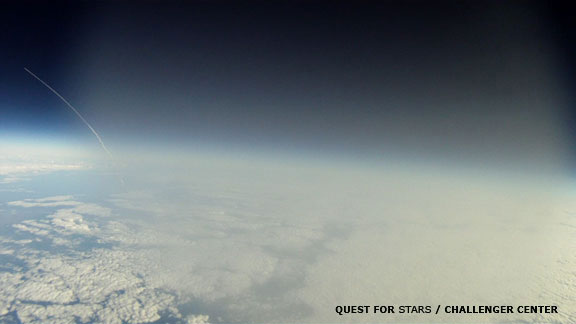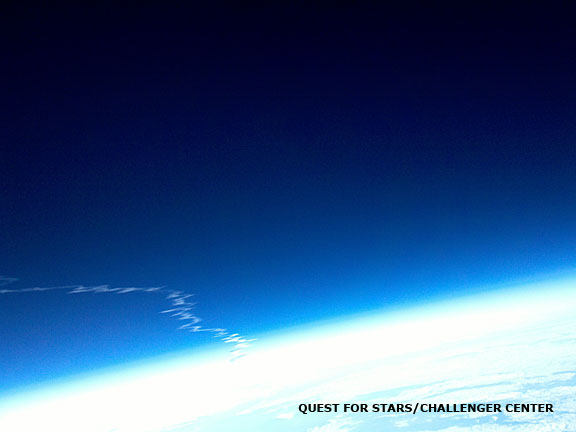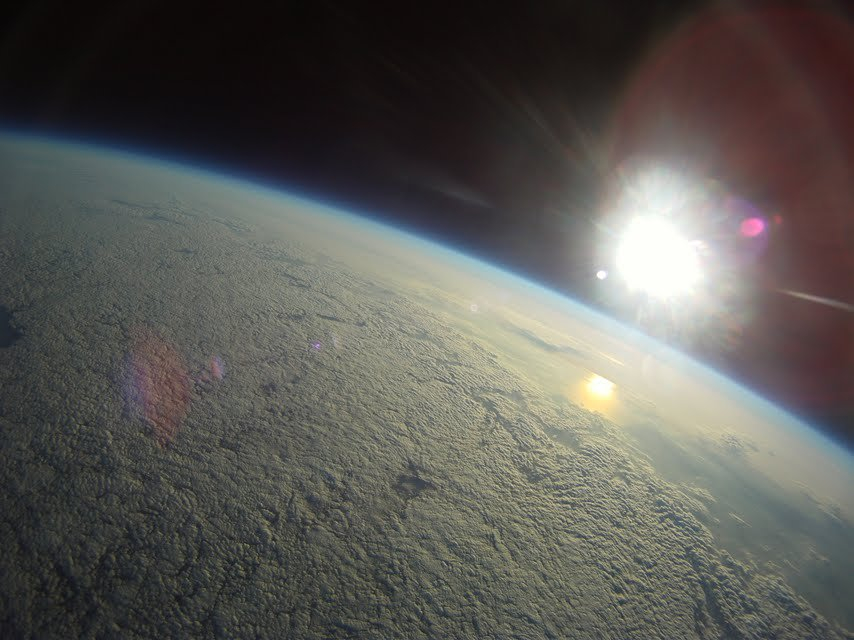
A camera-toting balloon captured dramatic photos of NASA's shuttle Discovery streaking into orbit on its final flight yesterday (Feb. 24), snapping the images from the edge of space as part of a non-profit student project.
In one of the photos, Discovery arcs off planet Earth, leaving a trail of exhaust in its wake. Another shows the shuttle's exhaust plume torn to shreds in the high-altitude river of air called the jetstream.The balloon snapped photos from an altitude of more than 70,000 feet (21,200 meters), project organizers said.
Dicovery launched into orbit at 4:53 p.m. EST (2153 GMT) from NASA's Kennedy Space Center on its 39th and final mission, ahead of the shuttle program's retirement later this year. [Photos of Shuttle Discovery's Last Launch]
The balloon – nicknamed Robonaut-1 in honor of the Robonaut-2 robot riding on Discovery – took to the skies about an hour earlier from a relatively nearby staging ground.
The student balloon mission is a joint effort of two non-profit educational organizations, the Challenger Center for Space Science Education and Quest for Stars. The California-based Quest for Stars lets middle-school and high-school students help place balloon-borne experiments at the edge of space using relatively cheap, off-the-shelf hardware.
Robonaut-1 rose toward the edge of space, getting in position to observe the historic launch. When Discovery came into view, the balloon was ready — it snapped multiple pictures, capturing the shuttle and the wafting vapor trail it left behind.
More amazing views are expected to follow, project organizers said.
Get the Space.com Newsletter
Breaking space news, the latest updates on rocket launches, skywatching events and more!
"We are processing the images now and we not only got it in stills, we got it flying on video," Quest for Stars founder and CEO Bobby Russell said in a Twitter message today (Feb. 25). "We are looking for the best ones now."

Sshuttle-watching space balloon
Quest for Stars equipped the helium-filled Robonaut-1 with a payload consisting of multiple cameras, an onboard computer system, mobile phones and a Global Positioning System (GPS) device. Project organizers said the effort was accomplished on the cheap, with off-the-shelf technology.
High schoolers from San Diego pitched in, helping to waterproof the balloon's payload bay, Russell said.
Everything went off without a hitch.
The smartphones aboard Robonaut-1 took good video and stills of the launch from high up in the sky, above 70,000 feet. The balloon rose until it couldn't contain its ever-expanding helium, at which point it popped. The camera package descended to Earth via parachute.
The mission's recovery team then chased the deflated balloon, following its signal to the landing site.
"We made it to the impact site after dark," Russell tweeted yesterday. "On-board homing beacon said we were less than 500ft but too dark to see. We resume at 0600."
The team found the balloon this morning, then began going through the pictures.

An educational mission
Quest for Stars travels to middle schools and high schools to brief students on missions like these, and then brings the resulting images and souvenirs back to the kids.The group doesn't charge the schools or students anything, Russell said — it's funded by donations.
The main goal of such missions is to get students excited about science by letting them participate in the process. The group hopes to help inspire the next generation of scientists and engineers, Russell said.
Robonaut-1's flight was the second mission Quest for Stars has run for and with schools. It's planning another balloon launch next month, Russell said, and hopes to expand from there.
The Robonaut-1 flight was the first joint mission operated by Quest for Stars and the Challenger Center for Space Science Education, an organization set up in 1986 by families of the astronauts lost in the space shuttle Challenger accident that year.
Discovery's STS-133 mission is the shuttle's final mission after nearly 27 years of spaceflight. NASA is retiring all three of its reusable space planes this year, marking the end of the 30-year space shuttle program.
During an 11-day mission, Discovery's six-astroanut crew will deliver the humanoid robot Robonaut 2 and a storage room to the International Space Station. Two spacewalks are planned to upgrade and maintain the orbiting lab.
You can follow SPACE.com senior writer Mike Wall on Twitter: @michaeldwall. Visit SPACE.com for complete coverage of Discovery's final mission, STS-133.
Join our Space Forums to keep talking space on the latest missions, night sky and more! And if you have a news tip, correction or comment, let us know at: community@space.com.

Michael Wall is a Senior Space Writer with Space.com and joined the team in 2010. He primarily covers exoplanets, spaceflight and military space, but has been known to dabble in the space art beat. His book about the search for alien life, "Out There," was published on Nov. 13, 2018. Before becoming a science writer, Michael worked as a herpetologist and wildlife biologist. He has a Ph.D. in evolutionary biology from the University of Sydney, Australia, a bachelor's degree from the University of Arizona, and a graduate certificate in science writing from the University of California, Santa Cruz. To find out what his latest project is, you can follow Michael on Twitter.









